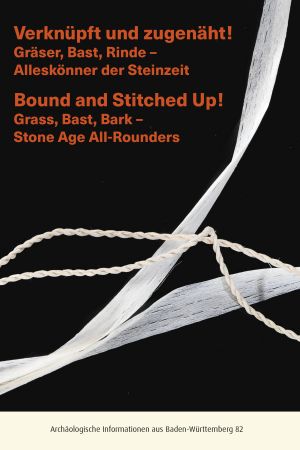
How to Cite
Banck-Burgess, Johanna and Rösch, Lisa-Maria (Eds.): Verknüpft und zugenäht! Bound and Stitched Up ! Gräser, Bast, Rinde – Alleskönner der Steinzeit / Grass, Bast, Bark – Stone Age All-Rounders, Heidelberg: Propylaeum, 2020 (Archäologische Informationen aus Baden-Württemberg, Volume 82). https://doi.org/10.11588/propylaeum.643
License

This work is licensed under a Creative Commons Attribution-ShareAlike 4.0 International License.
Published
09/23/2020
Verknüpft und zugenäht! Bound and Stitched Up !
Gräser, Bast, Rinde – Alleskönner der Steinzeit / Grass, Bast, Bark – Stone Age All-Rounders
The textiles found at the prehistoric lake dwelling settlements were true all-rounders. A wide range and variety of raw materials reveal an astonishing variety of applications. The interdisciplinary research project “THEFBO” (2018–2021) investigates the cultural and historical significance of textiles for the early agricultural communities. This booklet accompanies the touring exhibition and contains comprehensive articles from the project partners as well as interviews covering the diversity of the theme.
Chapters
Table of Contents
Pages
PDF
Nachhaltige Ressourcen in der Vorgeschichte – über die Verarbeitung von Rinde und Bast / Sustainable Resources in Prehistory – Processing Bark and Bast
19-21
Auf dem Prüfstand – Materialeigenschaften von Lindenbast und Faserlein / Putting it to the Test – Material Properties of Lime Bast and Flax Fibre
22-26
Einführung in die Archäobotanik der Körbe – das Fach und die wissenschaftlichen Methoden / Introduction to the Archaeobotany of Baskets – the Discipline and the Scientific Approaches
29-36
Die Herstellung von Lindenbast in der Praxis – eine studentische Übung / The Production of Lime Bast in Practice – a Student Exercise
37-40
Textilien aus den Feuchtbodensiedlungen am Bodensee und in Oberschwaben / Textiles from the Wetland Settlements on Lake Constance and in Upper Swabia
50-58
Wie man einen Spiralwulstkorb herstellt – basierend auf einigen neolithischen Funden / How to Make a Coiled Basket – Based on some Neolithic Finds
61-69
Glücklos und trotzdem ein voller Erfolg – zur Rekonstruktion eines Rindengefäßes / Unfortunate and yet a Complete Success – the Reconstruction of a Bark Container
76-78
Detailreich – das gemusterte Gewebe aus Pfäffikon-Irgenhausen / Very Detailed – the Patterned Fabric from Pfäffikon- Irgenhausen
83-85
Feuchtbodenarchäologie – Grabungstechnik und Funde / Wetland Archaeology – Excavation Technique and Remains
92-98
Vom Wasser bewahrt – zur Erhaltung organischer Materialien in der Feuchtbodenarchäologie / Preserved by Water – the Conservation of Organic Materials in Wetland Archaeology
101-106
Ur- und Frühgeschichte ausstellen – historischer Abriss und Konzept der THEFBO-Ausstellung / Exhibiting Prehistory and Proto-History – Historical Overview and Concept of the THEFBOExhibition
108-116
„Einfach genial – genial einfach: Schnüre und Seile im prähistorischen Alltag“ – ein Austausch unter Kolleg*innen / “Simply Ingenious – Ingeniously Simple: Cords and Ropes in Prehistoric Everyday Life” – Sharing Information between Colleagues
118-122






